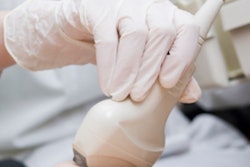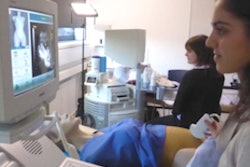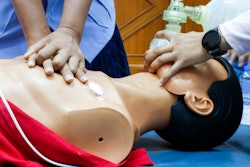
Work-related musculoskeletal disorders still remain a bane for sonographers, if a recent survey in Sweden is any indication. However, much can be done to improve sonographer working conditions and decrease the prevalence of pain, researchers reported in a study to be published in the January 2017 issue of Applied Ergonomics.
In a survey of nearly 300 sonographers in Sweden, a team led by Jenny Gremark Simonsen of Lund University found that a higher prevalence of musculoskeletal pain was associated with factors such as high work demands, high physical workload, eye complaints and headache from computer work, and dissatisfaction with computer workstations.
On the bright side, the researchers found that some factors -- such as adjustable equipment and adequate eyesight correction -- were associated with lower prevalence rates for pain.
"We recommend optimal visual conditions, adjustable components of the ultrasonic machine and the computer workstation, education concerning ergonomic guidelines, and regular health screening, including eyesight," the authors wrote. "In echocardiography, other ways of holding and handling the transducer should be developed," they added (Appl Ergon, January 2017, Vol. 58, pp. 245-253).
Pain and discomfort
Sonographers commonly experience pain and discomfort in the neck, upper limbs, and back. The growing popularity of ultrasound exams also has increased the number of exams and scanning hours for sonographers, potentially leading to a higher risk for work-related musculoskeletal disorders, according to the researchers.
In addition, echocardiography offers its own particular issues. Due to the depth of the heart in the body, echocardiography requires strong grip force on the transducer hand, which may lead to an increased risk of developing musculoskeletal disorders, according to the team.
The authors also noted that due to the setup in the examination room, "echocardiography is performed in one of a limited number of working techniques, but it is not known whether any of these is more favorable in terms of the risk of [work-related musculoskeletal disorders]."
In hopes of developing recommendations for improving sonographer working conditions, the researchers set out to explore the associations between sonographer physical and psychosocial working conditions with pain in the neck, shoulders, elbows, and hands. They also paid special attention to working conditions in echocardiography.
They sent a questionnaire to all sonographers in all 45 biomedical departments in Sweden that performed sonography. The study included all female sonographers who responded and worked at least 20 hours a week and performed sonography for a minimum of four hours per week. Due to their low number of responses, male sonographers were excluded from the analysis. The 291 respondents had a mean age of 44 years, a mean height of 167 cm, a mean body mass index (BMI) of 24, and mean sonography experience of 12 years.
The questionnaire included questions on personal characteristics, general working conditions and details on examination techniques, and musculoskeletal troubles the sonographers may have experienced during the preceding 12 months. A sonographer's physical workload was calculated using two measures: a mechanical exposure index and a physical exposure index. The mechanical exposure index is based on 11 items relating to awkward work postures, static workload, and precise movements, while the physical exposure index concerns handling of materials, according to the researchers. The team then calculated prevalence ratios to assess associations for personal- and work-related factors with neck/shoulder pain and elbow/hand pain.
High prevalence of pain
Of the 291 respondents, 169 (58%) met the criteria for neck/shoulder pain, while 85 (30%) had elbow/hand pain. Overall, 189 (65%) had pain in any or both regions, according to the group.
In terms of personal factors, an older age was associated with neck/shoulder pain, while a higher BMI and having children at home were associated with elbow/hand pain.
The researchers found a number of work-related factors associated with sonographer pain in the neck/shoulders:
- Years of experience as a sonographer
- Dissatisfaction with their computer workstation
- High job demands
- High sensory demands
- Inadequately corrected eyesight
- Eye complaints related to computer work
- Headache related to computer work
"The possibility to adjust the keyboard and chair was associated with less pain," the authors wrote.
Similar issues were associated with sonographer pain in the elbows/hands:
- A high mechanical exposure index (measure of physical workload)
- Eye complaints related to computer work
- High job demands
- High sensory demands
The researchers also observed that echocardiographers had a higher prevalence of pain in the elbows/hands than those who did not perform echocardiography.
While no specific factor in echocardiography was found to be associated with neck/shoulder pain, the researchers did find that performing echocardiography studies from 91 to 135 minutes per day was associated with elbow/hand pain. They also determined that a transducer grip with the wrist bent backward was associated with a high prevalence of elbow/hand pain in sonographers who perform echocardiography. Holding the transducer in a two-handed/alternating grip, however, was associated with a low prevalence of elbow/hand pain.
Recommendations
Most of the sonographers in the study reported a high or moderately high physical workload (as measured by the mechanical exposure index), and the researchers found a strong association between increasing physical workload and pain. High sensory demands -- such as requirements for small and very precise movements and precise eyesight -- may lead to long-time static postures in neck and shoulders, as well as wrists and hands, according to the researchers.
"This may be an explanation to the strong associations between high sensory demands and pain in these regions," the authors wrote. "High sensory demands seem to be unavoidable in sonography, thus it is important to optimize work conditions concerning ergonomics."
Given the association between eye strain and pain in both the neck/shoulder and elbow/hands, it is "thus extremely important to ensure that all sonographers have adequate eyesight correction and to optimize lighting conditions and contrast on the screen," according to the researchers.
The association with sonographer dissatisfaction with their computer workstation and neck/shoulder pain is likely a proxy for poor ergonomics, according to the team. As a result, the study authors strongly recommended adherence to available recommendations for good computer ergonomics.
They also noted that sonographers who perform echocardiography showed a higher prevalence of pain in the elbows/hands and that pain was more prevalent in the hand and shoulder used to operate the transducer.
"Keeping the wrist straight when pressing the transducer against the patient seemed protective, in accordance with basic ergonomic principles," the authors wrote. "Holding the transducer [with a] two-handed/alternating grip was associated with a lower prevalence of pain, and this should be encouraged."
The use of voice activation also has been shown to reduce the number of times the operator has to reach for the control panel and make both hands available to handle the transducer, they noted.
The authors pointed out that guidelines for preventing work-related musculoskeletal disorders in sonography are available and were published in 2003 in the Journal of Diagnostic Medical Sonography.
"These recommendations are well in line with the findings in this study and should be more widely spread to encourage further improvements and interventions of the working environment," they wrote. "Since the prevalence of pain was high, we also suggest regular health screening for early detection and prevention of pain related to the working environment."



















